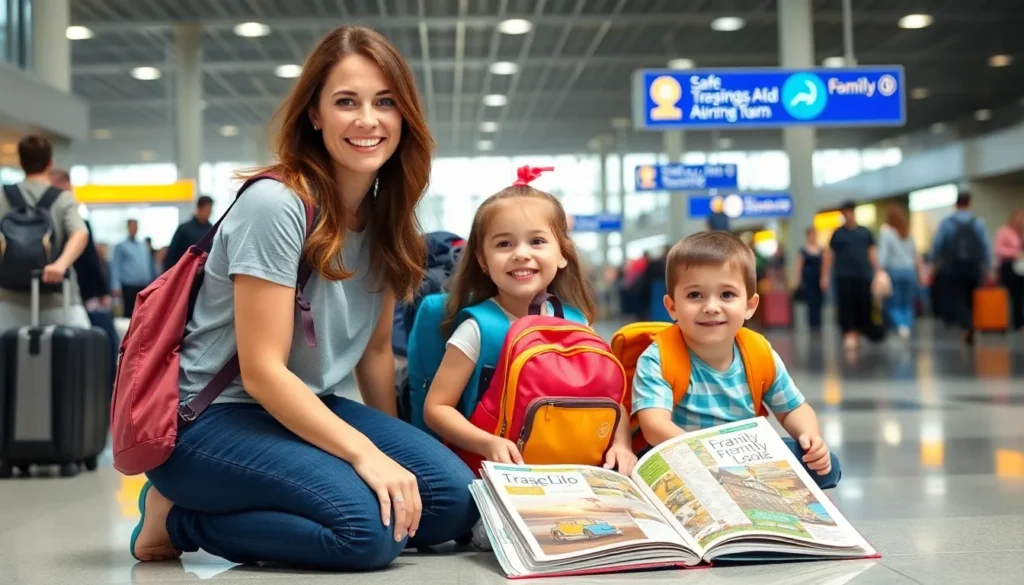Planning a family trip can feel like herding cats—chaotic and slightly impossible. Yet, the secret to a smooth journey lies in one simple word: flexibility. Whether it’s a last-minute change in destination or a spontaneous detour for ice cream, being adaptable can turn a stressful vacation into a memorable adventure.
Table of Contents
ToggleUnderstanding Family Travel Flexibility
Family travel flexibility refers to the ability to adapt plans during trips. It encompasses changing itineraries, adjusting schedules, and being open to new experiences.
Definition of Family Travel Flexibility
Family travel flexibility means having the freedom to change plans without stress. This adaptability includes responding to children’s moods or unexpected weather changes. Flexibility allows families to explore new destinations and enjoy spontaneous adventures. When families embrace this approach, travel becomes less about rigid schedules and more about shared experiences.
Importance of Flexibility in Family Travel
Flexibility plays a crucial role in making family trips enjoyable. Stress often arises from strict itineraries or unanticipated challenges. When families stay adaptable, they reduce frustration and create a more relaxed atmosphere. Unforeseen events, like flight delays or last-minute attractions, can enhance travel fun. Embracing flexibility not only fosters family bonding but also encourages resilience in children. Engaging in unexpected activities often leads to unforgettable memories. Prioritizing adaptability can truly transform a family vacation into a memorable adventure.
Benefits of Family Travel Flexibility

Families face multiple challenges during trips, making flexibility essential. By adapting plans, they reduce stress and create positive experiences.
Stress Reduction
Traveling with children can lead to unexpected situations. Flexibility minimizes anxiety by allowing families to adjust schedules. For instance, if a planned activity doesn’t suit the children’s mood, families can choose an alternative. Embracing spontaneity helps alleviate tension, ensuring the trip remains enjoyable. Adjustments to itineraries accommodate changing weather or fatigue, enhancing overall comfort. Stress reduction fosters a peaceful atmosphere that supports family bonding.
Enhanced Experiences
Flexibility opens the door to unique opportunities. Families often discover local attractions or activities they might not have considered. Exploring new options, like impromptu visits to parks or cultural sites, enriches the travel experience. Making last-minute changes can lead to unexpected adventures that create lasting memories. This adaptability encourages families to fully engage with their surroundings. Through flexibility, they unlock a richer travel narrative that extends beyond the original itinerary.
Strategies to Achieve Family Travel Flexibility
Achieving family travel flexibility requires thoughtful planning and choices. Implementing strategies enhances enjoyment and accommodates unexpected situations.
Planning for Flexibility
Drafting itineraries involves balancing planned activities with free time. Allocate buffer periods between scheduled events to allow for spontaneous exploration. Prioritize must-see attractions while remaining open to changes based on children’s interests or moods. Incorporate a mix of structured and unstructured time to foster relaxation. Assess weather forecasts prior to departure, and adjust plans accordingly. This proactive approach builds family resilience and creates an adaptive travel mindset.
Choosing Flexible Accommodations
Selecting accommodations adds an essential layer of flexibility. Opt for hotels or rentals with flexible cancellation policies, allowing for changes as needed. Choose locations central to attractions, minimizing travel time and accommodating spontaneous outings. Family-friendly amenities, such as kitchen facilities, enable easier adjustments to meal times. Book accommodations that offer diverse room configurations, providing options for changing family dynamics. A flexible lodging choice enhances traveling experiences and facilitates a more comfortable stay for everyone.
Challenges of Maintaining Travel Flexibility
Traveling with family presents unique challenges that can threaten flexibility. Unexpected scheduling conflicts frequently arise, particularly when coordinating activities for multiple family members. Children’s school commitments or extracurricular activities can force families to adjust plans quickly. Rotating schedules between parents often complicates the logistics further. Rescheduling reservations for attractions, dining, or accommodations may lead to limited options. Tight deadlines or overlapping commitments can create stressful situations, demanding an immediate reassessment of the travel itinerary.
Budget constraints add another layer of complexity. Families often face financial limitations that require careful planning and adaptability. Unexpected expenses can emerge, such as medical needs or travel disruptions. These financial surprises can force a realignment of activities and accommodations. Prioritizing experiences based on available funding is essential. Choosing budget-friendly options like local eateries or free attractions helps balance enjoyment and costs. Recognizing when to make sacrifices ensures family travel remains enjoyable without compromising financial stability.
Embracing flexibility in family travel can truly transform the experience. By adapting plans and remaining open to change families can navigate the unexpected with ease. This approach not only reduces stress but also fosters deeper connections among family members.
When families prioritize flexibility they create opportunities for spontaneous adventures and memorable moments. It’s about enjoying the journey together rather than sticking to a rigid itinerary. With thoughtful planning and a willingness to adjust families can ensure their trips are both enjoyable and enriching.
Ultimately the key to successful family travel lies in balancing structure with adaptability. By doing so families can turn potential challenges into cherished memories that will last a lifetime.





